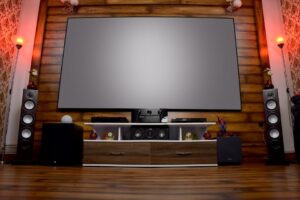Smart Home Theater Speakers: 10 Powerful Best Picks 2025
The Future of Home Cinema: Smart Speakers Transform Entertainment
Smart home theater speakers combine cutting-edge audio technology with wireless connectivity and intelligent features to create immersive entertainment experiences without the traditional cable clutter. For those looking to upgrade their home cinema setup, here’s what you need to know:
- What they are: Wireless speakers with built-in Wi-Fi, Bluetooth, voice assistants, and streaming capabilities
- Key benefits: Cable-free setup, voice control, multi-room audio, automatic calibration
- Popular options: Premium soundbars with Dolby Atmos, wireless satellite speaker systems, and 360° Spatial Sound technology
- Budget range: $300-$2,000 depending on configuration and features
Gone are the days when creating a theater-like sound experience meant running speaker cables across your living room and wrestling with complex AV receivers. As one industry expert noted, “Many homeowners would leave rear speakers in the box rather than deal with cable mess.” Today’s smart speakers solve that problem with wireless technology that doesn’t compromise on sound quality.
Modern smart home theater systems deliver Dolby Atmos and DTS:X immersive audio through sleek components that blend into your décor. Whether you opt for a single intelligent soundbar or a complete multi-speaker setup, these systems integrate seamlessly with your existing smart home ecosystem.
What makes these speakers truly “smart” isn’t just their wireless connectivity—it’s their ability to optimize sound for your specific room, respond to voice commands, receive feature updates over time, and work with other connected devices in your home.
The latest systems can even create what manufacturers call “phantom speakers,” generating up to 12 virtual sound sources from just 4 physical speakers. This technology uses advanced digital signal processing to map your room’s acoustics and deliver sound that seems to come from places where no speakers exist.

What Are Smart Home Theater Speakers?
Ever wondered what makes a speaker “smart”? Smart home theater speakers are much more than just regular speakers with a fancy label. They’re complete audio systems with their own brains, wireless connectivity, and intelligent features all wrapped up in sleek packages that can transform your living room into an immersive entertainment space.
Unlike traditional speakers that just sit there waiting for audio signals, these clever devices have built-in Wi-Fi and Bluetooth, freeing you from the tangle of cables that typically connect to TVs or media players. They’re designed to work seamlessly with your favorite streaming services like Spotify, Apple Music, and Amazon Music, letting you send audio directly to them without any middleman.
What truly sets smart home theater speakers apart is what’s happening inside. They’ve eliminated the need for bulky AV receivers by packing their own amplifiers and processors into their compact frames. This integration not only saves space but makes setup a breeze for anyone intimidated by traditional home theater wiring.
The wireless technology powering these systems has come a long way too. Advanced wireless audio technologies can deliver high-resolution, multichannel audio (up to 24-bit/96 kHz) over their own 5 GHz networks with virtually no delay. This means you can enjoy true wireless surround sound without compromising on quality.
One of the most loved features has to be multi-room audio capability. Systems today let you group speakers throughout your home for perfectly synchronized playback everywhere, or play different content in different rooms—all controlled from a simple app on your phone. Imagine starting your movie soundtrack in the living room, then having it follow you to the kitchen when you grab snacks!
How Smart Home Theater Speakers Differ From Traditional Setups
Traditional home theaters typically involve multiple components: an AV receiver doing the heavy lifting of decoding audio formats, amplifying signals, and distributing sound to passive speakers through a web of speaker wires. While this approach offers flexibility, it also comes with complexity that can be intimidating for many people.
Smart home theater speakers take a completely different approach that focuses on simplicity without sacrificing performance:
First, they use sophisticated Digital Signal Processing (DSP) to optimize sound for your specific room. These speakers can analyze their surroundings and adjust audio output to compensate for room shape, furniture placement, and even ceiling height.
Instead of fiddling with complicated remote controls, you manage everything through intuitive smartphone apps that give you precise control over every aspect of your system. These apps often include helpful setup guides and visual equalizers that make fine-tuning your sound a pleasure rather than a chore.
Many systems include automatic calibration features that use built-in microphones to measure your room’s acoustic properties. After a quick setup process (often taking just minutes), the system adjusts itself for optimal performance in your specific space—something that would require professional help with traditional setups.
Perhaps most exciting is that smart home theater speakers get better over time. Through over-the-air updates, manufacturers can add new features, improve performance, and fix bugs long after purchase. Your system actually improves the longer you own it!
As one reviewer said about a premium wireless speaker system: “It’s downright eerie to listen for the first time because you hear a big, detailed soundstage yet see no speakers.” This perfectly captures how these smart systems create immersive experiences that seem to defy the physical placement of the speakers themselves.
Core Components Inside a “Smart” Speaker
To truly appreciate what makes smart home theater speakers special, let’s peek under the hood:
At the heart of every smart speaker is a System-on-Chip (SoC) that functions as its brain. This tiny powerhouse combines processing, memory, and connectivity in one package, handling everything from decoding complex audio formats to running voice assistant software.
For those who love hands-free control, these speakers include arrays of far-field microphones designed to catch your voice commands from across the room—even when your action movie is in full explosion mode. These mics use clever algorithms to separate your voice from background noise.
Modern smart speakers typically use efficient Class-D amplifiers that generate less heat and consume less power than traditional amps. This efficiency allows for smaller enclosures without sacrificing audio quality or volume capability.
Room equalization hardware is another critical component. Dedicated DSP chips analyze your room’s acoustics and apply complex equalization to optimize sound. Advanced Sound Field Optimization, for example, uses dual microphones in each speaker to measure their relative position and height, creating a 3D map of your space.
Beyond basic Wi-Fi and Bluetooth, many systems include specialized wireless modules for speaker-to-speaker communication. These ensure that all speakers play in perfect sync, with minimal latency that could otherwise ruin your movie experience.
By integrating all these components into cohesive systems, smart home theater speakers deliver experiences that would require multiple separate devices, specialized knowledge, and complex setup in traditional home theaters—making immersive audio accessible to everyone, not just audio enthusiasts.
Smart Home Theater Speakers: Key Features & Specs to Prioritize
Shopping for smart home theater speakers can feel overwhelming with all the technical jargon thrown around. Let’s break down what actually matters when you’re looking to create that perfect movie night experience at home.
Audio Format Support
The magic words you’ll want to look for are Dolby Atmos and DTS:X. These aren’t just fancy marketing terms – they genuinely transform how you experience sound. Unlike traditional surround sound that simply circles around you, these formats create a three-dimensional bubble of audio where sounds can come from any direction – even above you!
I love how quality compact soundbars cleverly deliver Dolby Atmos effects without actual upward-firing speakers. They use sophisticated processing to trick your ears into hearing height. That said, if you want the full experience, systems with dedicated height speakers will make that helicopter flyover sound much more convincing.
Connectivity Options
Your speakers need to talk to your TV, and HDMI eARC is the conversation starter you want. This connection handles uncompressed Dolby Atmos and DTS:X audio with ease – something older optical cables simply can’t manage.
Keep an eye out for the Matter standard in newer speakers too. Think of Matter as a universal language that different smart home devices can speak, regardless of brand. Many Google devices already support Matter, and the list grows every month. This means your speakers will play nicely with other smart gadgets, even if they’re from different manufacturers.
Performance Specifications
When comparing specs, here’s what actually impacts your experience:
Latency is all about timing – lower numbers mean better lip-sync in movies and faster response in games. Nothing ruins immersion faster than dialogue that doesn’t match mouth movements!
Power output (measured in watts) generally indicates how loud your system can go before distortion. More power doesn’t necessarily mean better sound, but it does provide headroom for dynamic movie soundtracks.
Frequency response tells you the range of sounds the speaker can reproduce. A wider range (ideally 20Hz-20kHz) means you’ll hear everything from the deepest rumbles to the highest tinkles.
If you’re considering mounting speakers overhead, our detailed guide to Smart Ceiling Speakers covers everything from installation tips to smart home integration.
Must-Have Immersion Tech for 2024
The latest smart home theater speakers use some truly mind-bending technology to create immersive experiences:
Object-based audio is revolutionizing how we experience sound. Instead of assigning sounds to specific channels (like traditional 5.1), these systems treat each sound as an independent object that can move anywhere in your room. The effect is startlingly realistic.
Even without physical speakers above you, height virtualization technology can create convincing overhead audio. It’s not quite as precise as dedicated speakers, but the effect can still be goosebump-inducing during the right movie scene.
The latest wireless speaker systems showcase what modern tech can achieve with 360 Spatial Sound Mapping. Using just four physical speakers, they create what sounds like a complete 7.1.4 system. As one user described it: “It’s eerie how precisely you can hear a plane flying overhead or footsteps behind you” – all from just four speakers strategically placed around the room.
Connectivity & Ecosystem Compatibility
Your smart home theater speakers should play well with your existing tech ecosystem:
Wi-Fi 6 provides faster, more reliable streaming with less interference from your neighbor’s networks – crucial when you’re streaming high-resolution audio.
Bluetooth 5.3 offers improved range and stability compared to older versions, perfect for quickly connecting a friend’s phone at your next gathering.
If you’re an Apple user, look for Apple AirPlay 2 support for seamless integration with your iPhone and Mac. Android fans will appreciate Chromecast built-in for easy streaming from compatible apps.
Voice control through Amazon Alexa, Google Assistant, or Siri lets you adjust volume, skip tracks, or even dim your smart lights without reaching for a remote – perfect for those moments when you’re comfortably settled in with popcorn.
Privacy & Security Considerations
The convenience of smart speakers comes with legitimate privacy questions. Look for these features to maintain control:
A physical microphone mute button provides peace of mind – when it’s off, it’s truly off. Some newer systems offer local voice processing for basic commands, keeping your data on the device rather than sending it to the cloud.
Data encryption ensures that any information transmitted to cloud services remains secure, while features like Guest Mode let visitors use your speakers without accessing your personal accounts or leaving their listening history in your profile.
These privacy features mean you can enjoy the convenience of smart technology without feeling like you’re sacrificing your personal information in the process.
Choosing the Right System for Your Room & Budget
Finding your perfect smart home theater speakers isn’t just about buying the most expensive system—it’s about matching technology to your specific space and needs. Think of it like buying shoes: the perfect pair for someone else might leave you uncomfortable after just a few hours.
Room Size Considerations
Your room’s physical characteristics dramatically impact how sound behaves within it. Larger rooms naturally need more powerful speakers to fill the space properly, while smaller rooms can actually sound worse with too much speaker power creating muddy echoes.
When planning your setup, consider your room’s dimensions carefully. That cozy 10×12 bedroom needs a very different approach than your 20×30 open-concept living area. Ceiling height matters tremendously too, especially for those immersive Dolby Atmos effects that make rain sound like it’s falling directly above you.
Your seating distance from the TV affects everything. Sit too close to powerful speakers and you’ll notice unbalanced sound; too far and dialogue becomes unclear. For ideal placement, position your main seating area about 70% of the way back from your front wall—this creates what audio engineers call the “sweet spot” where sound converges most naturally.

Entry-Level Small Rooms (<250 sq ft)
In smaller spaces like apartments or bedrooms, less is often more. A powerful 7.1 system would overwhelm these rooms both physically and acoustically.
For these cozy spaces, smart soundbars offer remarkable performance from minimal footprint. Quality compact soundbars create convincing virtual surround sound that feels much bigger than their compact size suggests. Most people are genuinely surprised at how immersive modern soundbars can be—all without running a single speaker wire.
If you want true surround sound without the complexity, budget wireless kits deliver genuine 5.1 immersion for under $1,600. These systems eliminate the traditional AV receiver entirely, making setup almost as simple as plugging in power cords and pressing a sync button.
For many apartment dwellers, a smart soundbar paired with a wireless subwoofer hits the sweet spot. You’ll get dramatically improved dialogue clarity and that satisfying room-filling bass when explosions happen on screen—without annoying the neighbors too badly.
Mid-Range Living Rooms (250-500 sq ft) – “smart home theater speakers” sweet spot
Medium-sized living rooms represent the perfect playground for smart home theater speakers. These spaces offer enough room for proper speaker placement while remaining practical for everyday family life.
The 5.1.2 configuration works beautifully in these spaces. Premium wireless systems include a primary soundbar, wireless subwoofer, two wireless rear speakers, and upward-firing drivers that bounce sound off your ceiling for convincing height effects. The result? True Dolby Atmos immersion that makes you feel like you’re inside the action, not just watching it.
What makes mid-sized rooms particularly appealing is the flexibility to start small and expand. Quality wireless audio platforms let you begin with just a soundbar, then add wireless surrounds when budget allows, followed by a subwoofer, and eventually even ceiling speakers. Your system grows with your enthusiasm (and your paycheck).
The latest wireless speaker systems deserve special mention for mid-sized rooms with challenging layouts. Using just four physical speakers, advanced processing creates what sounds like a much larger system by generating “phantom speakers” between the real ones. It’s perfect for rooms where traditional speaker placement gets complicated by doorways, windows, or furniture.
Premium Cinematic Spaces (>500 sq ft) — “smart home theater speakers” for dedicated theaters
For those fortunate enough to have dedicated theater rooms, smart home theater speakers can deliver truly reference-quality experiences that rival commercial cinemas.
Larger spaces benefit from more sophisticated 9.1.4 configurations—nine main channel speakers, one subwoofer (though two is often better), and four ceiling speakers. Premium soundbar systems paired with additional surrounds and ceiling speakers exemplify this approach, creating a sound bubble so convincing you’ll find yourself turning to look at noises that seem to come from behind your walls.
In premium spaces, separating amplification from speakers while maintaining smart connectivity gives you the best of both worlds: audiophile-grade components with the convenience of wireless control and streaming. These systems cost more, but the performance difference is immediately noticeable even to casual listeners.
In-ceiling height speakers provide the most convincing overhead effects for Dolby Atmos content. While soundbars with upward-firing drivers work surprisingly well, nothing beats dedicated speakers positioned precisely where the sound should originate.
Curious about what all those specification numbers actually mean for real-world performance? Our guide on Understanding Audio Specs: What Do They Actually Mean? breaks down the jargon into practical insights.
For these premium spaces, consider professional calibration—it’s like having a tailor adjust a suit that already fits well. Many high-end smart systems include advanced room correction that professionals can fine-tune to your specific space, extracting every bit of performance from your investment.
Setup, Placement & Optimization
Proper setup and placement are crucial to getting the most from your smart home theater speakers. Even the most advanced system will underperform if poorly positioned or incorrectly configured.

Room Calibration
Remember when setting up home theater meant spending hours with a tape measure and sound pressure meter? Those days are thankfully behind us. Today’s smart home theater speakers do the heavy lifting for you through impressive automatic calibration features.
Most premium systems now include built-in or external microphones that analyze exactly how sound travels in your specific room. It’s like having a professional audio engineer in your home! These systems measure the distance from each speaker to your primary listening position and adjust timing accordingly, ensuring that sound from all speakers reaches your ears simultaneously.
The magic continues with intelligent crossover tuning. Your system determines the perfect frequency at which to transition bass from smaller speakers to the subwoofer based on each speaker’s unique capabilities. Some advanced systems even detect and compensate for reflective surfaces or absorptive materials in your room—like that plush sofa or those hardwood floors that can dramatically affect sound quality.
If you’re wondering why these optimizations matter so much, check out our article on Why Sound Quality Matters More Than You Think. The difference between a properly calibrated system and one that’s just “plugged in” can be truly night and day.
Wireless vs. Wired: Pros & Cons for “smart home theater speakers”
“Should I go wireless or stick with wires?” It’s one of the most common questions I hear from readers setting up smart home theater speakers. The answer isn’t always straightforward.
Wireless setups offer undeniable convenience. No more crawling under furniture to run speaker wire across your living room! This freedom allows for much more flexible placement options and makes reconfiguration a breeze when you rearrange furniture or move to a new home. The clean, cable-free aesthetic is also a huge win for many homeowners and apartment dwellers alike.
However, wireless isn’t without trade-offs. You might experience occasional interference or dropouts, especially in homes with crowded Wi-Fi environments. Each wireless speaker also needs its own power outlet, which can sometimes be more limiting than running speaker wire. There’s typically a price premium for wireless technology, and some systems may introduce slight latency that can be noticeable during dialogue-heavy scenes.
As one reviewer noted about a premium wireless system: “If experiencing dropouts, change Wireless Playback Quality from ‘Sound Quality’ to ‘Connection’ for more stable performance.” This perfectly illustrates how wireless systems often include settings to prioritize stability when needed.
For a deeper comparison on wireless audio quality, our article Bluetooth vs Wired Audio: Which One is Better? explores the nuances in detail.
Step-by-Step Quick-Start Guide
Setting up smart home theater speakers doesn’t have to be intimidating. Most modern systems follow a similar setup pattern that’s surprisingly straightforward:
Start by finding the optimal placement for each component. Position your soundbar or front speakers at ear level, either below or above your TV. Surround speakers work best when placed slightly behind your seating position at ear height. For your subwoofer, experiment along the front wall—contrary to popular belief, corners can sometimes create boomy, uneven bass. If you’ve invested in an Atmos system, position those height speakers on top of your front speakers or mount them on the ceiling for the most convincing overhead effects.
Next comes the easy part: plug everything in. Connect all speakers to power outlets and link your main unit to your TV via HDMI eARC for the best audio quality. Once everything’s powered up, it’s time for the smart features to shine.
Launch the manufacturer’s smartphone app and follow the guided setup process. When prompted, run the automatic room calibration—just be sure to remain quiet while the system plays its series of test tones. The results can be almost magical as your system maps your unique space.
Finally, connect your favorite music streaming services through the app and set up any voice assistant preferences. Take some time to test your new system with different content types—a blockbuster movie, some music, and perhaps a sporting event to experience the full range of what your system can do.
The whole process typically takes less than 30 minutes, with the app holding your hand through each step. No engineering degree required!
Future-Proofing & Easy Expansion
One of the most delightful aspects of smart home theater speakers is their ability to grow with you over time. Unlike traditional systems that often require complete replacement to upgrade, smart systems accept modularity.
Many systems let you start with just a soundbar and add wireless surround speakers later when your budget allows. Some support dual subwoofers for more even bass distribution throughout larger rooms—a significant upgrade that doesn’t require replacing anything you already own.
Perhaps most exciting are the regular firmware updates that can add entirely new capabilities to your existing hardware. It’s like getting a new feature for free, long after your purchase. For example, premium wireless systems can be expanded with different subwoofer options depending on your room size and bass preferences.
When planning your system, think about both your current needs and future possibilities. That entry-level soundbar might be perfect for now, but choosing one from a brand with an ecosystem of compatible speakers could save you money in the long run.
For additional help with setting up and expanding your smart home devices, Google offers comprehensive support resources for their ecosystem products.
Frequently Asked Questions about Smart Home Theater Speakers
Are smart home theater speakers good for both movies and music?
Absolutely! One of the best things about smart home theater speakers is how versatile they are. While they’re designed to make your movie nights spectacular, they’re equally impressive when you’re just wanting to unwind with your favorite playlist.
If you’ve invested in a system with Dolby Atmos, you’re in for a treat. These systems don’t just make movie explosions sound more realistic—they also transform how you experience music, especially tracks mixed in immersive formats like Dolby Atmos Music or 360 Reality Audio. Imagine hearing your favorite band with instruments and vocals positioned all around you, including overhead!
Music lovers will appreciate several advantages these smart systems offer. They can synchronize music throughout your entire home, so the same song follows you from room to room. Many support high-resolution audio up to 24-bit/96kHz, revealing details in your music you might never have noticed before. And clever technologies like advanced digital improvement can actually improve the sound of compressed streaming music, restoring some of what was lost in compression.
I was struck by one reviewer’s experience testing a premium wireless system with Sara K’s “Hell or High Water” SACD. Despite being primarily designed for movie thrills, the system delivered what they called “remarkable transparency and precise imaging”—audiophile-speak for “it sounded amazing.”
How difficult is it to expand a starter kit later?
Adding to your smart home theater speaker system later is refreshingly simple—manufacturers have intentionally designed these ecosystems to grow with you. This means you can start with something basic that fits your budget now and add more components as your wallet recovers!
The expansion process is typically straightforward: buy compatible speakers, plug them in, open the manufacturer’s app, and follow the “Add Speaker” instructions. After a quick recalibration to integrate your new speakers, you’re good to go. The whole process usually takes less than 15 minutes.
Some systems make this even easier. The latest wireless audio systems use advanced technology that automatically detects and pairs new compatible speakers as soon as you power them on—no complex setup required. Quality wireless platforms, while requiring an app-based setup, make the process so intuitive that even your tech-challenged relatives could handle it.
The key to hassle-free expansion is choosing a system from a manufacturer with a robust ecosystem of compatible products and a history of supporting their products long-term. This ensures that when you’re ready to add those rear speakers or a second subwoofer two years from now, compatible options will still be available.
Should I worry about voice-assistant privacy in my theater room?
It’s perfectly reasonable to have privacy concerns about smart home theater speakers with built-in voice assistants. After all, the idea of having always-listening microphones in your living room can feel a bit unsettling. Fortunately, manufacturers have taken these concerns seriously, giving you several ways to maintain control over your privacy.
Most voice-enabled speakers include physical mute buttons or switches that disconnect the microphones at the hardware level—not just in software. This means when the mute is activated, it’s physically impossible for the device to listen, regardless of what’s happening in the digital world. Leading manufacturers include dedicated microphone mute buttons right on their remote controls.
You can also manage your privacy through app settings. Voice assistants typically let you review and delete your voice history, and some systems offer a “Guest Mode” that prevents voice interactions from being saved to your account—perfect for when you’re hosting movie night with friends.
The good news is that you don’t have to choose between smart features and privacy. You can disable voice assistants entirely while still enjoying wireless streaming, automatic room calibration, and app control. Many users find that manufacturer apps provide a more comprehensive control experience anyway, making voice commands optional rather than essential.
These systems are designed to improve your entertainment experience, not complicate it with privacy worries. With the right settings, you can enjoy all the benefits of smart home theater speakers while keeping your conversations private.
Conclusion
Imagine walking into your living room, pressing a single button, and being instantly transported to a movie theater, concert hall, or gaming arena—all through the magic of sound. That’s the promise of smart home theater speakers, and they’re delivering on it better than ever before.
These systems have truly transformed how we experience entertainment at home. Gone are the days of tangled wires, complicated receivers, and speakers that never quite sound right. Today’s smart audio solutions combine wireless convenience with sophisticated sound processing that adapts to your specific room.
When selecting your perfect system, think about what matters most to you:
Your room’s size and shape will largely determine what configuration works best—a sleek soundbar might be perfect for your apartment, while a larger space might benefit from separate speakers that create a more enveloping soundfield.
Consider how you’ll primarily use the system. Movie buffs might prioritize Dolby Atmos support for those overhead helicopter sounds, while music lovers might care more about high-resolution audio formats and stereo imaging precision.
Don’t forget about your existing tech ecosystem! If you’ve already invested in Google Home devices throughout your house, a system that plays nicely with Google Assistant will feel like a natural extension rather than a separate technology island.
Budget matters too, of course. The beauty of many modern systems is their expandability—you can start with a quality soundbar and add satellite speakers or a subwoofer when your wallet recovers.
And in our connected world, privacy considerations shouldn’t be an afterthought. Look for physical mute buttons and clear data policies if you’re concerned about always-listening microphones in your entertainment space.

Here at The Techie Genius, we believe technology should improve your life without complicating it. That’s why we’re passionate about cutting through technical jargon and marketing hype to help you find audio solutions that truly fit your lifestyle.
The “best” system isn’t always the one with the highest price tag or the longest feature list. It’s the one that disappears into your daily routine while changing your entertainment experiences—whether that’s making you jump when something goes bump in the night during a horror movie, or revealing subtle details in your favorite album that you’ve never noticed before.
For more in-depth guidance on selecting and setting up audio equipment for your smart home, check out our audio section. We’ve got everything from beginner guides to deep dives into the latest technology.
The perfect sound is waiting for you—and it’s probably easier to achieve than you think.







